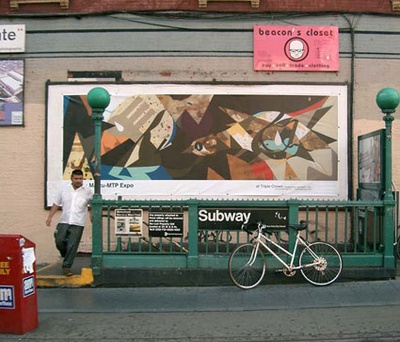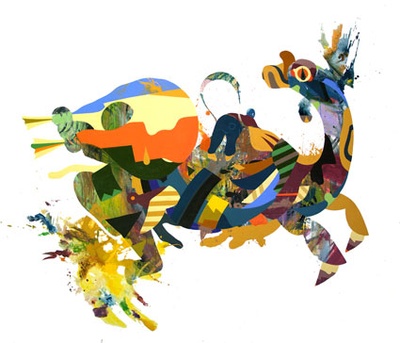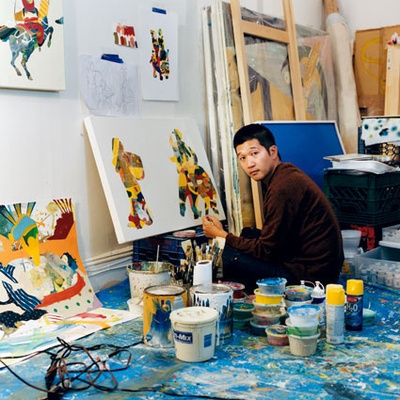The Brooklyn neighborhood Williamsburg crosses into Greenpoint just after the empty expanse of McCarren Park. It’s a brisk walk on a cold day, and veering onto Lorimer Street, I search for 31 year-old artist Tomokazu Matsuyama’s apartment for a studio visit. I pass one 1950’s family duplex after another down the vinyl-sided street. Greenpoint has become the latest haven for artists living and working in New York City. I can never remember the number. Matsuyama welcomes me to his apartment, waving me over from the center of the block five doors over. Walking up the stairs to his apartment, I slip off my shoes and enter, looking around, eager to see his new works.
He has not yet moved his work to his new studio, and canvases pile, packed side-by-side, in the room that for any other home would play host to a sofa and oversized television. On the floor is littered paper towels, a hairdryer — to dry paints no doubt, some takeout Tupperware containers filled with watered-down acrylic colors. One is opened and filled with a dark olive green. In the corner lies a cup full of brushes, so fine that I am reminded of a thin tuft of a feather’s tip. Others are filled with larger, flatter, heavy-handled brushes. Several new works are lying in view and he offers me matcha and a glance at his work. He is excited, something has happened. In the center of the room is a piece that covers much of the wall. It is a canvas surrounded completely in white with what seems like a large splatter of paint in the center. It is a controlled splatter, remixed with flat expanses of paint and a distinct figure, a dragon-like creature. It is 2006, and it is his breakthrough piece Kirin.
As in urban metropolitan settings, in the worlds of Matsuyama’s paintings different icons from various cultures touch non-sensically and yet exist naturally side-by-side like a Coca-Cola bottle set on a table in a sushi restaurant in Williamsburg, NY. In Matsuyama’s work Kirin, the artist uproots the traditionally revered icon of a mythological creature symbolizing “prosperity” and places it amid an abstract white space, dripping in a bright contemporary acrylic color palette. Also on the canvas, is painted a fumbling man with a cap, trying to climb up on the creature’s back. The artist is well aware that the artwork is being viewed within a U.S. art market where the original iconic cultural meaning of the kirin will be lost. Instead he has reappropriated the image, influenced by the work of Edo period woodblock printmaker Hokusai (1760-1849), and has set it into a patchwork of urban cultures. For Matsuyama, the artwork references his life suspended in a cosmopolitan city, whether it should be Tokyo or New York.
Matsuyama spent the very yearly years of his life in Hida-Takayama, Japan, a small rural textiles village known as “Little Kyoto” that still remains trapped in time — an homage to its height of activity in the Edo period. In the ’80s, the artist moved smack into the intercultural mix of suburban L.A. when his family transplanted itself to Orange County due to his father’s study as a Protestant pastor. Just nine years old, he saw his first large-scale graffiti piece on the street and became engrossed with street, graffiti and skater culture. But when he reached sixth grade, his family moved back to Takayama, leaving the young artist between both worlds, feeling as if he did not belong to one or the other. “I was brought up in Japan, but I was [also] brought up here. When I was here, people treat me as Japanese, but then Japan is such a conservative country when you are different than somebody else… they pick on you,” remembered Matsuyama of his childhood.
But the artist kept in touch with his own individuality through his skateboarding and snowboarding. For Matsuyama, developing his own technique and style helped him hone in on his identity and earned him an early career as a professional snowboarder in Takayama as well as most of the big resorts in the U.S. But, a bad fall left him in the hospital with two broken ankles and ten months of grueling physical therapy. It was at this time that he discovered his interest in art, starting to draw for lack of being able to skate or snowboard. He entered design school in Shibuya for college and began designing high-end street wear and collectible snowboards and was featured as a young artist in popular magazines such as Dazed and Confused and +81 when he was in his early twenties. But he wanted to expand the world of his creative possibilities and decided to move to New York to attend Pratt Institute.
I met Matsuyama in January 2002, two weeks after he arrived in New York. At that time he still went by his street tag name: Matzu-MTP. His signature character, his “reluctant worrier,” a squinting face that served as a sympathetic commentary on male conformity and strain of responsibility in Japanese everyday life, was well recognized within popular graffiti culture in both Japan and the U.S. He had moved into post-9/11 New York City, complete with its overcast of heightened fear. During this time, Matsuyama painted his large-scaled multi-canvas font-based work It Ain’t Easy to Love Your Foe (2003). Composed of six canvases, the work combines the artist’s earlier use of letterforms and commercial design along with an exaggerated play with negative space. Painted drips with edges that border on near-stencil perfection and the presence of his “reluctant worrier” faces masked into the letters “F-O-E,” each on a separate canvas, complete the work. The piece resonates from the time, emerging from his street-graffiti aesthetic influence, through his personal history as a son of a pastor, trying to deal with both his feelings of juvenile injustice and cultural difference experienced in the schoolyard, as well as coming to terms with the atmosphere of post-9/11 New York City.
Between 2003 and 2005, Matsuyama continued to develop his craft, studying the lives and work of modern and contemporary artists — from Monet, Picasso and Pollack to Koons and Murakami. He also found himself turning back to Japanese art, especially Edo period ukiyo-e woodblock prints and textile designs and palettes. In 2005, Matsuyama created his work Fl-ye, a work derived from the good luck symbol in traditional Japanese painting — the swan. He began to combine his techniques from design and graffiti along with modern abstract techniques of dripping paints and splashing colors, and developed a unique style that he explained as neither East nor West, but instead what he hoped to be able to erase cultural boundaries — a new visual language. “For me, I had to go through a big suffer[ing],” Matsuyama explained of living between the U.S. and Japan. “And what I am trying to do in my painting is trying to take that cultural border off, because that’s who I am. And, I’m just trying to find myself.”
Matsuyama’s latest work appropriates images that originated in Japan’s Edo period ukiyo-e woodblock prints of beautiful women, Bijin-Ga, as well as of the exquisite artistry of the spring pictures, Shun-Ga. The Shun-Ga prints feature sexual encounters using a complex 10-block multicolor technique. In Shunger (2006), the artist plays with contemporary polka dots and striped patterns paired with heaps of overflowing fabric, arms and legs, taken directly out of a combination of Edo period printmaker Toyokuni’s works, portraying highly emotive characters caught amid their sexual exploits. Yet the artist explains: “Most of my paintings is not about telling a story or indicating certain emotional content…it’s about appropriating whatever image I think can be re-translated to become evoking and capture the moment of our diverse lifestyle.” Matsuyama sets the imagery into a world of contemporary international mix of icons and patterns, thereby losing the original sense of the piece and its cultural belonging as a traditional Japanese erotic print. Instead, he consciously places them into the chaotic cosmopolitan context of his experience of everyday urban life — as being fluidly international, Japanese and American.

Billboard at the Bedford Avenue L-Train Stop in Williamsburg in Brooklyn featuring an image of Tomokazu Matsuyama's painting Fl-ye for the "In Situ Matzu-MTP: Exterior/Interior Exhibition."
For more information, visit the artist's official website.
© 2008 Alexandra Chang




